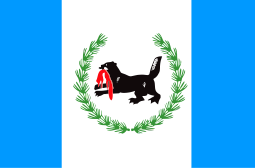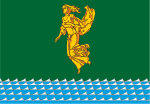
Irkutsk is the largest city and administrative center of Irkutsk Oblast, Russia. With a population of 587,891 as of the 2010 Census, Irkutsk is the 25th-largest city in Russia by population, the fifth-largest in the Siberian Federal District, and one of the largest cities in Siberia.

Tayshet is a town and the administrative center of Tayshetsky District in Irkutsk Oblast, Russia, located 669 kilometers (416 mi) northwest of Irkutsk, the administrative center of the oblast. Population: 35,485 (2010 Census); 38,535 (2002 Census); 42,391 (1989 Soviet census).

Usolye-Sibirskoye is a town in Irkutsk Oblast, Russia, located on the left bank of the Angara River. Population: 74,762 (2021 Census); 76,047 (2010 Census); 90,161 (2002 Census); 106,496 (1989 Soviet census).

Nizhneudinsk is a town and the administrative center of Nizhneudinsky District of Irkutsk Oblast, Russia, located on the Uda River, 506 kilometers (314 mi) northwest of Irkutsk, the administrative center of the oblast. Population: 36,999 (2010 Census); 39,624 (2002 Census); 43,759 (1989 Soviet census); 39,700 (1970).

Cheremkhovo is a town in Irkutsk Oblast, Russia, located on the Trans-Siberian Railway.

Ust-Kut is a town and the administrative center of Ust-Kutsky District in Irkutsk Oblast, Russia, located 961 kilometers (597 mi) from Irkutsk, the administrative center of the oblast. Located on a western loop of the Lena River, the town spreads out for over 20 kilometers (12 mi) along the left bank, near the point where the Kuta River joins from the west. Population: 45,375 (2010 Census); 49,951 (2002 Census); 61,165 (1989 Soviet census).

Baykalsk is a town in Slyudyansky District of Irkutsk Oblast, Russia, located 35 kilometers (22 mi) from Slyudyanka, the administrative center of the district. Population: 13,583 (2010 Census); 15,727 (2002 Census); 16,406 (1989 Soviet census).

Zima is a town in Irkutsk Oblast, Russia, located at the point where the Trans-Siberian Railway crosses the Oka River. Population: 32,508 (2010 Census); 34,899 (2002 Census); 41,814 (1989 Soviet census).

Slyudyanka is a town and the administrative center of Slyudyansky District of Irkutsk Oblast, Russia, located at the southern tip of Lake Baikal, 126 kilometers (78 mi) south of Irkutsk, the administrative center of the oblast. Population: 18,574 (2010 Census); 19,118 (2002 Census); 19,872 (1989 Soviet census).

Tulun is a town in Irkutsk Oblast, Russia, located on the river Iya, 390 kilometers (240 mi) northwest of Irkutsk. Population: 44,611 (2010 Census); 51,848 (2002 Census); 52,903 (1989 Soviet census).

The coat of arms of the Jewish Autonomous Oblast is the official coat of arms of the Jewish Autonomous Oblast in Russia. It consists of a Siberian tiger standing on four legs with the tail and the head turned upwards, of which the latter is facing the observer. This specific position and occurrence of the tiger symbolizes the history and development of the Oblast. The coat is a heraldic French shield and the background represents the color of the geographical characteristics of the Russian Far East, which includes taigas, hills, and meadows.

Balagansky District is an administrative district, one of the thirty-three in Irkutsk Oblast, Russia. Municipally, it is incorporated as Balagansky Municipal District. The area of the district is 6,634.7 square kilometers (2,561.7 sq mi). Its administrative center is the urban locality of Balagansk. Population: 9,194 (2010 Census); 9,973. The population of Balagansk accounts for 44.7% of the district's total population.

Mamsko-Chuysky District is an administrative district, one of the thirty-three in Irkutsk Oblast, Russia. Municipally, it is incorporated as Mamsko-Chuysky Municipal District. The area of the district is 43,396 square kilometers (16,755 sq mi). Its administrative center is the urban locality of Mama. Population: 5,501 (2010 Census); 7,990 ; 18,895 (1989 Soviet census). The population of Mama accounts for 66.0% of the district's total population.

Nizhneilimsky District is an administrative district, one of the thirty-three in Irkutsk Oblast, Russia. Municipally, it is incorporated as Nizhneilimsky Municipal District. The area of the district is 36,823 square kilometers (14,217 sq mi). Its administrative center is the town of Zheleznogorsk-Ilimsky. Population: 55,096 (2010 Census); 63,727 ; 77,291 (1989 Soviet census).

Shelekhovsky District is an administrative district, one of the thirty-three in Irkutsk Oblast, Russia. Municipally, it is incorporated as Shelekhovsky Municipal District. It is located in the south of the oblast. The area of the district is 2,020 square kilometers (780 sq mi). Its administrative center is the town of Shelekhov. Population: 14,435 (2010 Census); 11,836.

Ziminsky District is an administrative district, one of the thirty-three in Irkutsk Oblast, Russia. Municipally, it is incorporated as Ziminsky Municipal District. The area of the district is 7,000 square kilometers (2,700 sq mi). Its administrative center is the town of Zima. Population: 13,383 (2010 Census); 14,420 ; 15,833 (1989 Soviet census).
Balagansk is an urban locality and the administrative center of Balagansky District, Irkutsk Oblast, Russia. It is located on the left bank of the Angara River, downstream from Svirsk and 285 kilometres (177 mi) by road northwest of Irkutsk and to the southeast of Sayansk. Population: 4,109 (2010 Census); 4,307 (2002 Census); 4,136 (1989 Soviet census).
Alexeyevsk is an urban locality in Kirensky District of Irkutsk Oblast, Russia. Population: 2,529 (2010 Census); 3,164 (2002 Census); 3,685 (1989 Soviet census).
Artyomovsky is an urban locality in Bodaybinsky District of Irkutsk Oblast, Russia. Population: 1,539 (2010 Census); 2,186 (2002 Census); 3,773 (1989 Soviet census).
Atagay is an urban locality in Nizhneudinsky District of Irkutsk Oblast, Russia. Population: 1,740 (2010 Census); 1,853 (2002 Census); 4,177 (1989 Soviet census).


























































